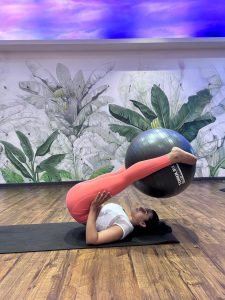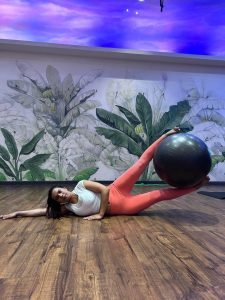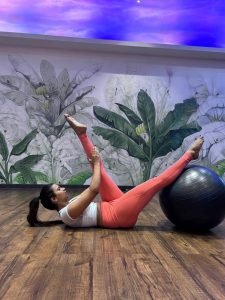Blog
Benefits Of Pilates on Stability Ball
- February 10, 2024
- Posted by: Kiran Sharma
- Category: Pilates


Pilates is getting to be popular in India. The only hitch is almost all exercisers want to start on the Reformer bypassing Pilates on Mat and the Ball! The Ball is an integral part of the Pilates apparatus – low priced, easy to transport and versatile. Noted Pilates master trainer Kiran Sharma explains how the stability Ball can help us in Pilates.
[Credit: All images of Kiran Sharma]
A lot of fitness trainers wanting to get into Pilates ask me if Pilates on Ball does help. For many of them, it is like a direct jump from Matwork to the Reformer!
The Ball could well be considered as a “poor man’s reformer”. It is indeed the next logical step from Matwork. It is ill advised to progress to the Reformer and other apparatus without extensive learning and regular practice on the Ball.
Pilates focuses on developing core strength and stability; it improves range of motion about the joints (flexibility) and generally enhances overall body awareness – finetuning proprioception or the “sense of position” in relation to one’s own body.
The Ball is a popular versatile “apparatus” in Pilates. Commonly known as the “exercise ball” or “Swiss ball”, it provides several benefits: from improving balance and stability to enlarging your ROM envelope. Herein, we will see the benefits of using the stability Ball in Pilates workouts and how it can raise the fun, intensity variation in your workouts to newer levels!
Balance and Stability

The Ball challenges your body’s stability and balance simply because it requires you to engage your suite of core muscles and stay centered on the Ball. As you begin to exercise on the Ball, your body reacts by activating deep stabilizing muscles, helping you gradually improve your balance.
The improved stability is not only beneficial in your Pilates workout but also in day-to-day functioning activities thereby lessening the risk of injuries, improving overall motor and neuromuscular control in and of your body.
Core Muscles
The “core” – or, your trunk – not merely the “abs” – is the engine of Pilates. The Ball intensifies the engagement of the core muscles in every movement that your body executes. Whether you sit, lie, or kneel on the ball, your core muscles work continuously to maintain your balance and alignment. This “deliberate” targeted core engagement helps you develop a strong and stable core, resulting in better posture and lower stress on your lower back.
Range of Motion

The Ball in Pilates exercises allows for a wider ROM compared to performing the same movements on a stable surface like the mat. Since it supports your body weight, you can stretch and move better, thus enhancing flexibility and mobility. The increased ROM is beneficial for persons who may have restricted flexibility or suffer from joint stiffness.
Multiple Muscle Suites
The Ball engages not only the core muscles but other muscle groups too. Whether you are executing squats, push-ups or knee flexions or extensions, the “unstable” Ball constrains your muscles to work synergistically, resulting in a better balanced and functional workout. This intensive, concentrated muscle engagement helps you to effectively build strength and tone muscles.
Posture and Body Alignment

The label Joseph Pilates gave this body of exercise – Body Contrology – is apt. It is all about maintaining correct body alignment and promoting good posture. The instability of the Ball challenges your body to find its center and maintain correct alignment during exercises – not just in Pilates but in all other exercise formats.
Low-Impact Exercise Alternative
There is no doubt: the Ball offers a low-impact exercise alternative that is suitable for exercisers across all fitness levels including those with joint problems or recovering from injuries. The cushioned Ball lessens impact on the joints, making it a gentle but effective way to exercise and increase strength.
Versatile and Fun

Pilates on Ball introduces fun and variation in workouts. It allows you to perform a wide range of exercises – beginner to advanced – keeping your workouts engaging, enjoyable and thus sustainable. Its versatility also means you can easily incorporate it into other exercise formats like weight training, yoga or aerobic exercise.
Pilates – anywhere, everywhere!
One of the best things about the Ball is its portability and ease of use. Easily inflated and deflated, it is great for home use or carrying to the gym. Its compactness means you can store it away when not in use. Of course, most certainly, it is an economical addition to your exercise equipment collection at home or in the gym.
Incorporating the Ball into your workouts effectively intensifies your Pilates experience and bolsters your overall fitness progression. From improving balance and stability to increasing ROM and at the same time engaging multiple muscle suites, the Ball offers an array of benefits that support the principles of Pilates.

Whether you are a Pilates buff or a beginner looking to add variations to your exercise routine, Ball is a versatile and effective tool to help you achieve fitness goals like balance, flexibility, and strength through more enjoyable and rewarding workouts.
We at GAYO Fitness Academy have been delivering Pilates Teacher training programs since 2009! Our courses are accredited Level 4, EREPS, Brussels. We invite you to explore and enjoy with us the magic of Pilates.
What is the Stability Ball?

The stability ball – otherwise known as a fitness, gym or Swiss ball – is made from soft elastic and filled with air. The ball is unstable and therefore it helps increase your stability!
They come in a range of sizes (ranging from 45cms – 85cms in diameter) to suit people of different heights. When used in the right way, the Ball’s curvature can offer a good alternative to the Pilates apparatus known as the ladder barrel for those people who want to practice equipment-type Pilates outside of the studio setting – that is, at home or in the park.
Stability Ball Size Chart
Select a ball size that is proportionate to your height. You ought to be able to sit on your ball with your legs at a 90-degree angle – may be slightly more but not less. Your thighs should be parallel to the ground or angled slightly down. With your feet flat on the floor and spine straight and erect, your knees should be even with or slightly lower than your hips.
This guide from the American Council on Exercise (ACE) is helpful for selecting the stability ball.
Height Exercise Ball Size
Under 5 feet 45 cm
Between 5 feet and 5 feet and 5 inches 55 cm
Between 5 feet and 6 inches and 6 feet and 2 inches 65 cm
Over 6 feet and 2 inches 75 cm
Getting the right exercise ball for your weight also matters. If you are heavy for your height, you may need a larger ball to keep your knees and legs at the correct angle. Look for a durable, thick ball with high burst resistance. Check the weight rating on the ball before buying.
Exercise Ball Inflation
For most exercises, you need to have a little “give” on the ball’s surface. When you sit on the Ball, your body weight should create a little, indented seat. It provides more stability, but more importantly, it allows you to sit evenly on the Ball. Good postural alignment is a “must”.
The more inflated the Ball is, the more difficult it will be to balance on it, whether sitting or in another position. So, how much air you will pump into the Ball is a matter of preference but do not over-inflate!
Leave a Reply
You must be logged in to post a comment.
